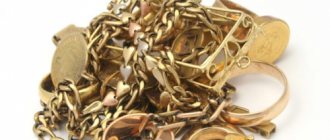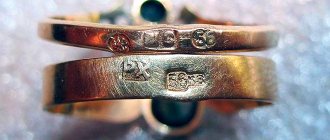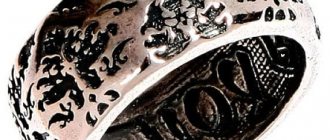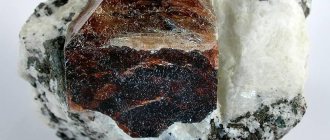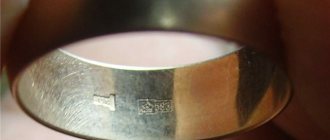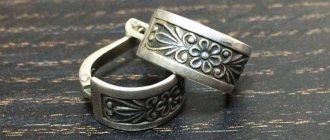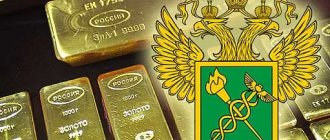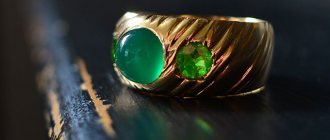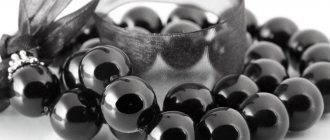Museum of Trade - Commodity Dictionary - Jewelry (Part 2)
Jewelry (Part 1)
Name tags usually had the shape of a rectangular platform on which a short alphabetic (sometimes in combination with numbers) designation of the name of the enterprise was placed with the addition to the right of the last digit of the year of manufacture of this product (1959 is conventionally designated by the number 9; 1960 by the number 0, etc. .). The number indicating the year of manufacture of the product was included in the general frame of the name sign. An exception to this rule was the name form of the “Artist” artel of the Dagestan Autonomous Soviet Socialist Republic (Kubachi village), which put on its products an icon in the form of an image of a lotus flower, in the center of which were the letters “AH” (Artel artel) and the last digit of the year of production products.
Names and letter designations of jewelry (code)
Bracelets B , BR ; Brooches BR , BS , B ; Vases B ; VL plugs ; Decanters G ; Clamps 3 ; Cufflinks ZP ; ZN icons ; KL necklace ; Rings K ; KB Cups ; KN pendants ; Spoons L ; Spatulas for cakes LP ; Medallions M ; Thimbles N ; Leaf cutter knives NL ; Knives NZh ; Necklaces O ; Ashtrays P , PP ; Cup holders PD ; Egg coasters PYA ; Cigarette cases PR ; Powder compacts PDN ; Sockets P ; RM glasses ; Sugar bowls CX ; Earrings C ; Salt shakers SL ; Stacks ST ; Chains C ; Cups H ; Teapots CHN ; Sugar tongs Shch .
The passport was accompanied by a photograph of the product and, as the main control document, was kept (one copy each) in the files of the manufacturing enterprise, the wholesale trade base - the customer and the central department, the system of which included the enterprise that produced this product. In the quality control department of the manufacturing enterprise and at the wholesale trade base (in the assortment office or in the sample room), one copy of control samples (standards) of these products was constantly stored. Labels were attached to the standards under the seal, which included: the name of the manufacturer, the name of the product, the factory code, metal, weight, date and place of approval of the sample, price and price list item. The price and article number were also included in the passport. When setting the price, the product was assigned a corresponding product article - a number under which it was entered into the price list. Due to the constant updating of the assortment and the discontinuation of products of outdated styles, with each edition of a new price list there was some movement of items. The article numbers under which discontinued products were listed in the price list were assigned to newly produced products.
The article was a four-digit number, the first two digits of which indicated a group of products, the next digits indicated the serial number of the product for each group.
The indexes for product groups are as follows: gold - bracelets 01, brooches 02, pins 03, dental products 04, cufflinks 05, rings 06, pendants and necklaces 07, medallions 08, earrings 09, cigarette cases 10, chains 11; products with garnet stones 12, filigree 13, gold leaf 14, various products 16; coral beads 15; silver products by weight 25, piece 28, bracelets 30, hat pins 31, brooches 32, cufflinks 33, rings 34, pendants and necklaces 35, medallions 36, cigarette holders 37, thimbles 38, powder boxes 40, cigarette cases 41, earrings 43, chains 44, various 45, amber products 50; jewelry metal haberdashery made of brass and tombac - bracelets 51, brooches 52, pins 53, cufflinks 55, clips 56, earrings 57, pendants 58, medallions 59, powder compacts 60, various 61; cupronickel haberdashery - bracelets 73, brooches 74, buckles 75, cufflinks 76, rings 77, necklace 78, earrings 79, combs 80; made of aluminum 81; products from cupronickel - spoons 62, forks 63, knives 64, spatulas 65, crackers, candy bowls, shot glasses 66, cigarette cases 67, products from nickel silver 70, products from tombac 71-72, cases 69.
With the introduction of a new price list, jewelry that was in the retail chain was subject to relabeling with new items indicated. Products not included in the new price list were sold at the retail prices established for them with the letter “C” (discontinued) added to the article number.
The supply of jewelry to the retail trade network took place through the following channels: enterprise - central or interregional wholesale trading base - interregional or city trading office - store; in some cases, the enterprise is a store. The supply of mass and individual gold jewelry to the republican central wholesale bases was regulated by the USSR State Planning Committee. New product samples (their first batch), mastered by enterprises and approved by all authorities, were sent to the retail chain in small parcels marked “New Products” in order to identify consumer demand for them.
The external design of jewelry stores, in particular their display windows, played an advertising and popularization role. In showcases, they are usually displayed in groups: jewelry for women, toiletries, table setting items and interior decorations, souvenirs, writing instruments, etc. Products were selected either in the same color scheme, or, conversely, a contrasting decision was made both in color and and by the texture of various materials (for example, a group of silver and enamel items looks most colorful next to crystal items, ivory items acquire a more decorative sound next to black papier-mâché boxes with picturesque paintings, etc.). New items were placed directly behind the glass in the front (facade) part of the display case. The entire area of the back glass of the display case was usually draped with theatrical tulle or other translucent fabric. To illuminate the display cases, fluorescent light sources located in the upper part, covered with milk glass or a light-diffusing grille, were used. From the street and store sides, frosted stripes were applied to the display glass in the upper part, which created a surface that scattered light. Sometimes (mainly to display transparent, for example crystal, products) a hidden light source was used, enclosed in a light-weight lamp. In order to use the entire space of the display cases at different heights and in different plans, transparent light shelves made of glass or plastic and small shields on which jewelry were placed were hung on invisible (nylon) threads; part of the space was draped with light fabrics. Enlarged photographs, silhouettes made from bent wire, artificial and fresh flowers, auxiliary tablets and mannequins were also used to decorate the display windows. Lightweight mobile equipment made it possible to frequently change the design of display cases. Typically, the design of shop windows was subordinated by the artist-decorator to a single plot concept: seasons, new items of the season, methods of using various decorations, an exhibition and sale of a particular assortment, amber jewelry, Russian gems, souvenirs and gifts, etc. For in-store decoration and retail equipment The hall used wall cabinets and cabinets in which jewelry was displayed. The most expressive displays of small women's jewelry were large shields-stands, divided into separate sections in the form of circles, rectangles and other figures, covered with single-color dress fabrics, with individual jewelry pinned on them - brooches, rings, earrings, bracelets. To facilitate the selection of goods, posters, inscriptions and annotations were used that characterize certain jewelry items.
Sales of jewelry were usually concentrated in the sections: weighted silver, haberdashery and gold items. Weighted silver, just like gold items, was sold by weight, at prices set per 1 g, depending on one or another artistic treatment. For this purpose, the store had special technical scales of the 1st accuracy class. Haberdashery was sold individually. Some valuable jewelry was sold in cases, which were usually boxes of various shapes with a special slot for the corresponding item, covered on the outside with leather or its substitutes, and lined with silk or velvet on the inside. For cheaper products, cases were used, covered with lederin, with silk, semi-velvet or satin upholstery inside. Even cheaper products were sold in plastic bags or cardboard boxes covered with glossy or matte colored paper.
Rosyuvelirtorg had a special “Sample Room”, where specialists associated with jewelry art, production and trade had the opportunity to get acquainted with modern jewelry of domestic and foreign production.
State hallmark
A heart in Stas Mikhailov’s repertoire is made of pure gold (and then only as a metaphor), but not a precious coin or a piece of jewelry. Gold and silver items are durable and strong only because they are made from alloys. True, the share of silver or gold in them often exceeds 95%. The content of precious metal in products is called breakdown. It is designated by a three-digit number, since it expresses the mass in 1000 parts of the alloy. Control over the sample is the prerogative of the state. All jewelry sold or sold in Russia - whether domestically produced or imported - is marked with an hallmark. Marking is not placed on:
- coins that have been issued;
- nuggets used in “jewelry”;
- state awards;
- gold and silver leaf;
- small cuts with precious metal on boxes, vases and other valuable items.
In Russia, a certain list of jewelry samples is valid:
- 375, 500, 583, 750 and 958 – for gold;
- 750, 800, 875, 916, 925 and 960 – silver;
- 950 – platinum;
- 500 and 850 – palladium.
The metal content must correspond to the regulated values; its share in the product cannot be less than the applied sample. In an imported product it may be slightly larger. Testing and marking are carried out by state testing inspections.
Where to begin? From the basics
To begin with, look at what types of hallmarks there are and what they mean in the article by TD Serebro about silver.
Each piece of jewelry made of precious metal manufactured and sold on the territory of the Russian Federation is required by law to have two imprints:
- hallmarks of the Russian State Assay Chamber (from 2021 - Federal Assay Chamber);
- birthday boy.
The content of precious metal in the alloy is controlled by the state. It is regulated by Decree of the Government of the Russian Federation dated May 6, 2021 N 394 “On testing, analysis and branding of jewelry and other products made of precious metals.” Products made of precious metals manufactured in the Russian Federation, as well as imported for sale, must be marked with a state hallmark and comply with the Russian hallmark system.
The testing and hallmarking procedure is carried out by the Russian State Assay Office under the Ministry of Finance of the Russian Federation.
Deciphering the hallmark
The hallmark consists of two designations, which can be located either side by side or separately:
- the identification mark of our state is either a Soviet hammer and sickle in front and a star with five points in the background, which are still relevant as an assay mark, or a profile of a woman in a kokoshnik, turned to the right;
- sample sign.
Hallmark:
1 — Code of the State Assay Supervision Inspectorate 2 — Mark of the Assay Certificate 3 — Digital designation of the precious metal sample
Sketches of hallmarks on gold:
Sketches of an assay clamp for silver:
Advantages and disadvantages of 750 gold
The 750th gold standard is not as popular among buyers as the 585th, but it is also in demand. It contains a higher proportion of pure gold, which significantly increases the cost of the alloy, and at the same time the final product. Such jewelry is considered more elite, although it has a number of significant disadvantages, including:
- low strength due to the softness of the alloy;
- low resistance to mechanical damage;
- higher price.
Russian 585th standard gold
The 585th gold standard is one of the most common. In Soviet times it was 583, essentially the same thing. The gold content in the alloy has remained almost unchanged. This alloy made it possible to obtain an optimal combination of strength characteristics, relatively low cost and excellent color shade. Silver, copper, nickel and zinc are used as impurities.
